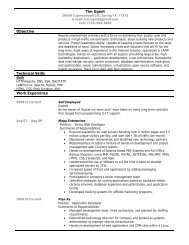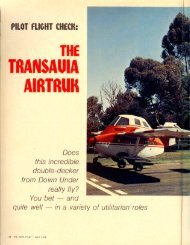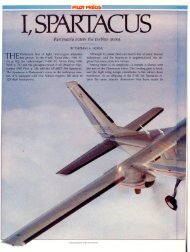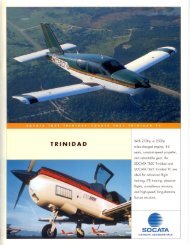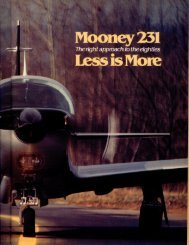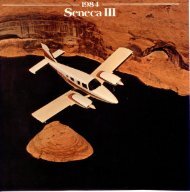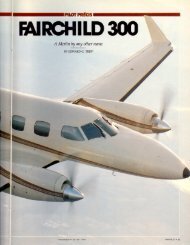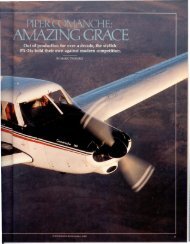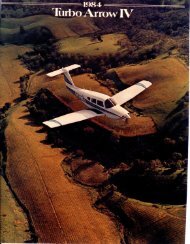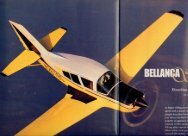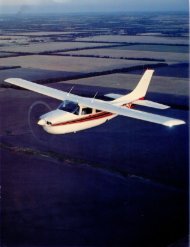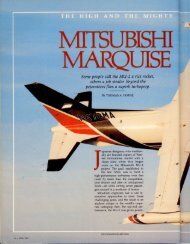Schweizer Sprite - Aero Resources Inc
Schweizer Sprite - Aero Resources Inc
Schweizer Sprite - Aero Resources Inc
You also want an ePaper? Increase the reach of your titles
YUMPU automatically turns print PDFs into web optimized ePapers that Google loves.
ontinued<br />
•<br />
Soanng----<br />
<strong>Schweizer</strong> <strong>Sprite</strong><br />
America's<br />
new<br />
no-frills,<br />
h igh -performance<br />
sailplane.<br />
BY THOMAS A. HORNE<br />
<strong>Schweizer</strong>-the American sailplane<br />
manufacturer-has been turning out<br />
sailplanes ever since 1930, when<br />
brothers Ernie, Paul and Bill first built<br />
their SGU 1-1. A host of designs has<br />
been produced over the years, but the<br />
most successful has been the 1-26. The<br />
1-26 is a single-seat sailplane, meant<br />
for fun as well as competition. It is the<br />
Cessna Skyhawk of American soaring,<br />
but with more pizazz.<br />
More sailplane pilots fly 1-26s than<br />
any other design, and more than 700<br />
have been sold. Also, more Federation<br />
<strong>Aero</strong>nautique Internationale (FAI)<br />
soaring awards for endurance, distance<br />
and altitude· have been earned by<br />
Americans in 1-26s than in any other<br />
type of sailplane. As you might suspect,<br />
the 1-26 has a devoted following;<br />
there is even a 1-26 Association.<br />
The 1-26 followed a gradual evolution<br />
from its beginning in 1954. The A<br />
models were fabric-covered, then came<br />
the B, a metal-winged version, followed<br />
by a kit model, the C. It was not<br />
until 1968, when the 0 model came<br />
out, that the 1-26 came equipped with<br />
spoilers. Along the way, more and<br />
more options were offered: wing-tip<br />
wheels, adjustable air vents and even<br />
armrests. In 1971 the 1-26E was introduced,<br />
with a monocoque fuselage. The<br />
only fabric-covered parts were the ailerons,<br />
rudder and horizontal tail. Over<br />
the years the gross weight of the 1-26<br />
went from the A's 575 pounds to the<br />
E's 700 pounds. The sailplane's glide<br />
ratio-23:1-remained unaffected.<br />
Glide ratio also is expressed as lift<br />
PHOTOGRAPHY BY THE AUTHOR
continued<br />
•<br />
Soanng<br />
over drag, or LID, and is a measure of a<br />
sailplane's ability to conserve altitude<br />
as it travels horizontally. The 23:1 figure<br />
means that for every 23 feet covered<br />
horizontally, the sailplane will<br />
sink only one foot. Provided, of course,<br />
that the pilot maintains the recommended<br />
airspeed for the best LID.<br />
Strangely enough, the I-26's LID is<br />
the same as that of the heavier 2-33<br />
trainer. The 2-33's larger and longer<br />
wings make this so.<br />
As popular as the 1-26 may be, its<br />
production days are over, something<br />
that is sure to be lamented by many. In<br />
its place, the <strong>Schweizer</strong>s have come out<br />
with their latest design-the 1-36, or<br />
<strong>Sprite</strong>. The first were delivered last<br />
September, and the company is aiming<br />
for a production rate of 50 per year.<br />
"A new sailplane for a new decade,"<br />
say the brochures, but what they really<br />
mean is that the <strong>Sprite</strong> will perform<br />
better at a lower cost than any other<br />
comparable sailplane on the market.<br />
When held at 46 knots, the <strong>Sprite</strong> will<br />
achieve its best glide ratio of 31:1. This<br />
means that the pilot can range over a<br />
wider area in his search for lift, enabling<br />
him to stay longer and travel<br />
farther than he could in a 1-26.<br />
At a base price of $18,750, the<br />
<strong>Sprite</strong> is the least expensive of the<br />
<strong>Schweizer</strong> line. It is probably the least<br />
expensive new sailplane in the world,<br />
<strong>Schweizer</strong> SGS 1-36 <strong>Sprite</strong><br />
Base price $18,750<br />
Specifications<br />
Wingspan<br />
Length<br />
Height<br />
Wing area<br />
Wing loading<br />
Aspect ratio<br />
Seats<br />
Empty weight<br />
Useful load<br />
Gross weight<br />
Performance<br />
46 ft 2 in<br />
20 ft 7 in<br />
4 ft 9 in<br />
140.72 sq ft<br />
5.05 lb/sq ft<br />
15.15:1<br />
1<br />
475lb<br />
2351b<br />
7101b<br />
Best lift/drag (LID) 31:1 @ 46 kt<br />
Minimum sink 2.25 fps @ 37 kt<br />
Limiting and Recommended Airspeeds<br />
Stall speed<br />
32 KIAS<br />
Auto/winch tow speed 48 to 52 KIAS<br />
<strong>Aero</strong> tow speed<br />
52 to 61 KIAS<br />
Va (Design maneuvering) 57 KIAS<br />
Maximum spoiler open speed 105 KIAS<br />
Vne (Never exceed)<br />
105 KIAS<br />
for that matter. When enough <strong>Sprite</strong>s<br />
are sold, it is likely that they will form<br />
the basis for another one-design-class<br />
competition movement. When competition<br />
events are limited to one design,<br />
it is a pilot's soaring ability that is put<br />
on trial, not his capability to buy the<br />
fanciest high-performance sailplane.<br />
This is what put the challenge in 1-26<br />
competition soaring.<br />
A bare-bones panel is standard on<br />
the <strong>Sprite</strong>: airspeed indicator, altimeter<br />
and magnetic compass. For coordinated<br />
turns, you can order an inclinometer or<br />
install your own yawstring free of<br />
charge. Also standard is a choice of either<br />
a taildragger or a nose-skid landing<br />
gear arrangement. In the taildragger<br />
model, the landing gear (a single 5- by<br />
5-inch main wheel with hydraulic disc<br />
brake) is mounted in a forward position,<br />
and there is a small tailwheel. In<br />
the nose-skid model, the wheel is<br />
mounted farther aft, there is a skid under<br />
the nose and a smaller skid at the<br />
tail. The taildragger is recommended<br />
for an individually operated <strong>Sprite</strong>; the<br />
nose-skid model is for the rougher use<br />
that a club- or group-operated sailplane<br />
can encounter.<br />
Many options are available, enabling<br />
the owner to expand the sailplane's capabilities,<br />
even if it is at the expense of<br />
weight. There are battery and radio<br />
installations, oxygen systems and<br />
34 • AUGUST 1981
..<br />
, i/<br />
,<br />
variometers. A variometer is an instrument<br />
that detects rising air and presents<br />
cockpit information in the form of<br />
., Lift/Drag (Glide Angle) "' I....-'-.<br />
.A 7 ---<br />
I<br />
~<br />
I<br />
an audible signal, a rate of climb indication<br />
or a rising ball in a calibrated ~<br />
'"<br />
26:] 34:]<br />
"-<br />
I<br />
""<br />
24:]<br />
Vs<br />
,I (Sinking Speed) \<br />
~<br />
glass tube. A variometer .-"'7<br />
:J<br />
j with audio capability<br />
runs close to $300, plus an in<br />
I~ Y-;/ ,~<br />
"" 30:] 22:] 28:] 20:]<br />
stallation charge.<br />
The <strong>Sprite</strong>'s cockpit, while it may<br />
look confining from the outside, is really<br />
quite well proportioned. Once inside,<br />
you settle into a very comfortable<br />
seat in a somewhat reclined position.<br />
The seat back can be set in one of several<br />
positions to allow for a pilot's<br />
comfort and size. There is even a headrest,<br />
and the length of the rudder cables<br />
can be adjusted to accommodate<br />
the pilot's legs. It is claimed that a sixfoot<br />
four-inch pilot can fit comfortably.<br />
Another noteworthy standard item is<br />
the Hooker harness, a high-quality,<br />
four-point restraint system with padded<br />
shoulder straps. It may not keep<br />
your head from hitting the canopy<br />
when you burst in and out of thermals,<br />
but it-and the high energy absorption<br />
design of the cockpit section-will give<br />
you maximum protection in case things<br />
go awry. The cockpit area is designed<br />
to collapse progressively. If you should<br />
hit something, the spun-aluminum<br />
nose cap will give way first, and from<br />
there on the structure provides more<br />
and more resistance.<br />
Closing the <strong>Sprite</strong>'s canopy requires<br />
some care. There are two locking pins<br />
that engage holes in the front and rear,<br />
and it is t:.asy to have only one engaged<br />
with the latch in the locked position.<br />
The <strong>Sprite</strong>'s controls are more responsive<br />
than the I-26's, so there will<br />
be more work on tow. Once you become<br />
familiar with the <strong>Sprite</strong>'s handling,<br />
though, you do not even notice<br />
this greater sensitivity. In fact, you<br />
even come to prefer it.<br />
<strong>Schweizer</strong> has a new, ratchet pitchtrim<br />
system that uses a narrow lever in<br />
front of the control stick. Squeeze the<br />
lever, release, and you have trimmed<br />
the sailplane to where you last positioned<br />
the stick. This permits virtual<br />
hands-off flying should you want it.<br />
Still, the stick can be moved in any direction;<br />
but if you let go, it will return<br />
to its originally trimmed location.<br />
When thermalling, you slow to the<br />
<strong>Sprite</strong>'s minimum sink speed of 37<br />
knots. At this speed the <strong>Sprite</strong> will sink at<br />
the rate of 2.25 feet per second (fps). The<br />
I-26's minimum sink speed is 33 knots,<br />
at which it will sink 2.6 fps. That turns<br />
~ ~ ~ w ro M<br />
Speed (knots)<br />
Performance curves for the <strong>Schweizer</strong> SGSl-36 Spril1' with a<br />
gross weight of 710 lb and a wing loading of 5.05 lb/sq ft.<br />
out to be 135 fpm versus 156 fpm. Not<br />
much difference, but every little bit<br />
counts. The advantage of the higher<br />
speed and lower sink rate is that the pilot<br />
is able to work a big, disorganized thermal<br />
better. When he goes up, he will go<br />
higher; and when he encounters sink, he<br />
will scoot through it faster than he would<br />
in a 1-26.<br />
Strapped in and tooling along at a.<br />
mighty 46 knots, it is easy to feel a<br />
part of the sailplane. The wings seem<br />
to sprout from your shoulders and the<br />
visibility is excellent, eliminating any<br />
feelings of claustrophobia. Pretty soon<br />
you will want to start playing.<br />
Loops, wingovers and spins are approved.<br />
The first two maneuvers call<br />
for an entry speed of 78 knots, and at<br />
that speed it does not take much control<br />
movement to get the desired result.<br />
For spins, enter with a slow deceleration.<br />
The <strong>Sprite</strong> spins energetically, but<br />
do be careful on the pull-out because,<br />
as we will see, there probably will be a<br />
lot of airspeed in the dive, thanks to<br />
the craft's slipperiness. It is a good<br />
thing that it is stressed to eight positive<br />
Gs and four negative.<br />
Spoilers can be used right up to redline-IDS<br />
knots-so you can use them<br />
to bleed off airspeed or altitude at any<br />
point in the normal flight envelope.<br />
In another article in this issue<br />
("Earning the Rating," p. 36), I talked<br />
l<br />
\<br />
ro<br />
]0<br />
6 ro<br />
~<br />
8<br />
.",~ '"<br />
n0"2::<br />
about how I received my glider rating<br />
(sound of fanfares). The ink from my<br />
solo endorsement was barely dry when<br />
Bernie Carris, the examiner-designee,<br />
asked if I wanted to fly the <strong>Sprite</strong>. Up<br />
to this time, all that I had heard about<br />
it was from the benches where students<br />
and pilots idly mouthed what<br />
their brains commanded.<br />
"Now theres a hot ship."<br />
"They'll never let me in that."<br />
"Heard it spins like a *:#: @ top."<br />
"Did you see him bounce"<br />
"Oh, it's a touchy one."<br />
And so on. Why do we listen to<br />
things like this Anyway, my time has<br />
come and, fugue-like, I notice my feet<br />
walking toward the waiting sailplane.<br />
Rumors ringing in my ears, I listen to<br />
my checkout. Carris is very blase. He is<br />
gazing off in the distance.<br />
"Well, it's just like the 1-26, really."<br />
Then a pause. Just when I think,<br />
'That's all" he says, "It might react a<br />
little faster, but, ahh, it's nothing really.<br />
You know, 46 for lift over drag, 37<br />
for minimum sink, land at 48 or 52, it<br />
doesn't much matter. You won't have<br />
any trouble. Go out and do some stalls,<br />
get the feel of it. ... "<br />
By now, I am strapped in. I look<br />
down at the panel and see two airspeed<br />
indicators, one labeled Forward, the<br />
other Aft. How come I ask.<br />
"Oh, this is our first <strong>Sprite</strong>, and we<br />
4<br />
2<br />
~<br />
AOPA PILOT • 35
continued<br />
used it for some tests during certification."<br />
Then I see, down on the placard,<br />
that this sailplane is <strong>Sprite</strong> No. 1. The<br />
leading edges of the wings show traces<br />
of new paint, so I ask about this, too.<br />
'They experimented with some<br />
leading-edge slots at one point, then<br />
decided not to use them, after all."<br />
Hot damn, I think. I feel like a test<br />
pilot now, and put my face into its serious,<br />
test-pilot look. The towplane<br />
takes up the slack.<br />
"Oh, yeah," Carris adds. "There's a<br />
guy coming over here to fly it at two<br />
o'clock, so have it back by then." I look<br />
at my watch and see that it is now one<br />
o'clock. I resolve to do my best and try<br />
to stay up the whole hour. If conditions<br />
are good, that man will have to<br />
wait for his ride.<br />
They switch tow pilots on me,<br />
Soaring<br />
wouldn't you know it And this new<br />
one flies up and down, all the way to<br />
3,000 feet; how badly I want to cut<br />
loose. With only a little more jockeying<br />
than I might have to put up with in a<br />
1-26, I am soon at release altitude, an<br />
aptly named title.<br />
As rank a sailplane pilot as I am, I<br />
manage to climb 1,000, 1,500, 2,000<br />
feet. Spiraling upward in the thermals<br />
is so easy that I tire of it after a while,<br />
feeling certain that I can find another<br />
one later. Time for some stalls.<br />
Hmmm, nice break, and wow, there<br />
goes the nose. This stall and others<br />
produce healthy breaks, but I never<br />
lose more than 150 feet.<br />
Spins like a top, eh We'll see about<br />
that. Stick slowly back and, below 35, all<br />
the way back with a rudder full in. Bingo.<br />
Round and round she goes, and after<br />
three times I have had enough. Neutralize<br />
rudders and stick forward, but loa<br />
much stick forward, as I now notice I<br />
am pointed at the Terminator. And<br />
what is that loud rushing sound Mercy<br />
me, the airspeed is 26 knots past<br />
redline. The internal scream is silenced<br />
and the pull-out begun. I lost 1,500<br />
feet on that one, and now I am looking<br />
for that thermal I promised myself.<br />
Now I know what they mean by<br />
"scratching for thermals." I get 200<br />
fpm here, 100 there, or sometimes only<br />
have enough lift to maintain altitude.<br />
When I do sink, though, it is not much.<br />
Eventually, I hit one. This sounds<br />
like someone banging on the right<br />
wing, so I bank hard to the right and<br />
see 1,000 fpm up. This goes on for a<br />
while and soon Iam back where I started.<br />
More thermals come along, so I de-<br />
-<br />
Earning the Rating<br />
With a few exceptions, the transition to soaring flight comes easily.<br />
BY THOMAS<br />
A. HORNE<br />
That whole week, everything became<br />
loose and light. In a lot of ways, it was<br />
like passing through a time warp into<br />
easier, simpler times.<br />
Warping began as I entered the<br />
Commuter Air Swearingen Metro. The<br />
copilot struggled to shut the door properly,<br />
while the passengers-all 18 of<br />
us-laughed openly at each repeated<br />
attempt. A dead-heading, Commuter<br />
Air pilot was sitting nearby. "We call<br />
these things 'Sweatros: " he smirked.<br />
From Washington National we flew<br />
over the rolling ridges and the aging<br />
communities of the East Coast Heartland.<br />
In circa-1950 airports, grandparents<br />
and children embraced; later that<br />
night they would watch television together.<br />
It is home.<br />
First stop, Wilkes-Barre, Pennsylvania.<br />
Then on to Binghamton, New<br />
York, where, for the next heartland<br />
penetration, the ship became smallera<br />
Piper Navajo, with the VFR code set<br />
in its transponder.<br />
In time I arrive at a log cabin in a<br />
glade of evergreen trees. This is Elmira,<br />
New York, home of the <strong>Schweizer</strong> Aircraft<br />
Corporation's soaring school.<br />
They train a lot of sailplane pilots here,<br />
and I am to become one more.<br />
Corky Gill is my instructor. About<br />
60 years old, ex-Thunderbirds chief<br />
mechanic and slow and deliberate. This<br />
week, dozens of times, he will say, "I<br />
don't fool around much with power<br />
planes any more:' with the same kind<br />
of arrogance that many serious sailplane<br />
pilots have.<br />
On a chalkboard in a side room, Gill<br />
draws a map of the local area, and I am<br />
given the briefing given to all power<br />
pilots taking the transition course. Gill<br />
sketches in all the Initial Points (of entry<br />
into the landing pattern) on the<br />
blackboard: the Twin Ponds, the Mall,<br />
and the Rest Area.<br />
A small pamphlet shows a topographic<br />
map of the area surrounding<br />
the Chemung County Airport. Concentric<br />
rings, labeled with minimum<br />
safe gliding altitudes, encircle the field.<br />
"Don't go fooling around Harris Hill<br />
any lower than 3,000 feet," Gill says.<br />
"Our best lift over drag speed will be<br />
50 mph, if we get lucky and find a<br />
thermal we'll slow to 42 and try to spiral<br />
up, and when we go to land we'll<br />
use 60, with spoilers and slips to control<br />
our descent angle."<br />
Our trainer is <strong>Schweizer</strong>'s Model 2<br />
33, the most popular trainer in the<br />
United States. Almost 600 have been<br />
sold since they first came out in 1967.<br />
If you decide to get your glider rating,<br />
chances are it will be in a 2-33. It<br />
seems to be a 1940s design, but looks<br />
are not everything. Besides, the 2-33 is<br />
strong. As we were to find out.<br />
Preflight is straightforward, with the<br />
advantage of the pilot being ablewith<br />
a few contortions-to see the<br />
wing-spar attach points and the aileron-cables<br />
bell crank through a hole in<br />
the rear of the cabin.<br />
The pre-takeoff check is even simpler:<br />
Set the altimeter, adjust the seat,<br />
secure the safety harness, close and<br />
latch the canopy, see that the controls<br />
are free and correct, set the trim, check<br />
the towrope and the release mechanism,<br />
and then exercise and check the<br />
spoilers. Just before takeoff you want<br />
to make sure the spoilers are in the<br />
closed and locked position.<br />
A thumbs up to the wing assistant<br />
means you are ready. He or she then<br />
36 • AUGUST 1981
cide to go as high as I can. I make it to<br />
8,300 feet. Then I look at the watch:<br />
2:30. I've done it. The man missed his<br />
ride. Now I know why you see so<br />
many more sailplane pilots waiting on<br />
the ground than you do in the air. Time<br />
to go back down.<br />
"Elmira Tower, sailplane seven will<br />
be landing shortly."<br />
Pattern speed is 57 knots, and you<br />
aim for 500 feet agl opposite the point<br />
of intended landing. The <strong>Sprite</strong> is a<br />
T -tail, but this makes little difference<br />
to the pilot in either the takeoff or<br />
landing phase. In the taildragger model,<br />
you have to apply a little more back<br />
pressure at the flare and touchdown so<br />
that the nose does not have a chance to<br />
scrape the ground. Make sure the<br />
spoilers are deployed when you do<br />
this, or you will find yourself bounding<br />
back into the air. All sailplanes fly eagerly<br />
in ground effect, and the <strong>Sprite</strong> is<br />
no exception. But the concentration on<br />
making a good nose-high touchdown<br />
can raise the ballooning potential.<br />
All in all the <strong>Sprite</strong> is an easy-to-fly<br />
sailplane. For a substantial increase in<br />
performance over the 1-26, the pilot<br />
barely knows he is in a different ship.<br />
If a brand-new sailplane pilot such as<br />
myself can squeeze 8,300 feet out of<br />
his first <strong>Sprite</strong> flight, it is not hard to<br />
imagine the kind of performance a<br />
more experienced pilot might obtain.<br />
There was mild debate within the<br />
<strong>Schweizer</strong> organization, some time ago,<br />
about whether or not to go to an all-fiberglass<br />
construction. The Europeans<br />
were doing it and achieving glide ratios<br />
of 50:1, so why not But those fancy<br />
European jobs are very work-intensive<br />
and sell for $50,000. And at that price,<br />
only a fanatical few will buy. You cannot<br />
stay in business that way, <strong>Schweizer</strong><br />
reasoned, so the manufacturer made<br />
a commitment to stay with aluminum.<br />
Aluminum, the company believes, is<br />
stronger and better able to stand up to<br />
the kind of storage found most often in<br />
America: tied down and exposed to all<br />
of the elements.<br />
For every pilot who decides to take<br />
up serious competition soaring, there<br />
are 20 others who only fly sailplanes<br />
for the fun of it. The <strong>Sprite</strong> is an acknowledgment<br />
of this. It is a sailplane<br />
that permits the student to transition<br />
easily from a trainer to a higher performance<br />
sailplane, it will soar well for<br />
the casual pilot, and it has the capability<br />
to reward the more serious types<br />
with a Diamond. 0<br />
w<br />
Z<br />
'"<br />
o<br />
:t<br />
<<br />
'" <<br />
::;<br />
o :t<br />
•...<br />
Spinning the 2-33 can be difficult, but you can<br />
try. Usually, the result is a fight spiral dive.<br />
, -<br />
o<br />
will lift the wing from the ground. The<br />
towplane inches forward, taking up the<br />
slack in the towrope. When the tow pilot<br />
wags his rudder he is asking if you<br />
are ready to go. You wag back, meaning<br />
you are.<br />
The tow is the most aggravating part<br />
of learning how to fly a sailplane. My<br />
first attempt is pretty sad. When a gust<br />
of wind sends us weathercocking, I react.<br />
But there is a lag in the response.<br />
The ailerons are not very effective at<br />
the beginning of the ground run. Or<br />
maybe we do not have enough airspeed<br />
ye't, I don't know. The wing tip whangs<br />
the ground hard, and we bound into<br />
the air, crabbed and cocked. I am not<br />
used to the actions of the control stick<br />
and carelessly let the ship settle back to<br />
the ground, the towplane already airborne.<br />
Another bang as the ship's tire<br />
hits the earth sideways. From behind I<br />
hear Gill let out a pained groan.<br />
Flying on tow is precision flying, but<br />
you will get the knack after just a few<br />
tries. My problems on the ground run are<br />
quickly identified and resolved. Ihad the<br />
mistaken idea that the sailplane should<br />
be held on the ground until the towplane<br />
became airborne. You can-and<br />
should-lift off before the towplane<br />
does. And small control movements are<br />
the rule; gross stick movements are out.<br />
You make an input, then take it out<br />
almost immediately.<br />
On the climbout you gently "walk"<br />
the rudders for lateral movement behind<br />
the towplane. Normally, you fly in the<br />
"high-tow" position, behind the towplane.<br />
You know you are in the high-tow<br />
AOPA PilOT· 37
confinued<br />
•<br />
Soanng<br />
I<br />
position when the top of the towplane's<br />
rudder is lined up with the towplane's<br />
greenhouse-the pilot's overhead window.<br />
On your third or fourth flight, you<br />
practice tow transitions, going from high<br />
tow to low tow as you fly a box behind<br />
the towplane. You are in low tow when<br />
the towplane's elevators and wings are<br />
lined up.<br />
When you receive your tow training,<br />
your instructor will warn you against<br />
allowing any slack in the towrope. This<br />
happens when you get careless in a<br />
turn or let the sailplane build up too<br />
much speed. Then the rope can bow.<br />
Canopy distortion can make you<br />
think you have slack in the rope when<br />
you really do not. But there is no mistaking<br />
a really big bow. These can be<br />
dangerous. If the bow is big enough<br />
and you are off to the side, the rope can<br />
come back around the wing and snare<br />
it, with disastrous consequences.<br />
Unless you are careful about slowing<br />
down when you take up the slack, the<br />
rope can jerk taut. The stress can cause<br />
it to break, another bad situation.<br />
It is a relief to pull that big, red knob<br />
. !r<br />
and be rid of that towplane. Pull- There is an informal pecking order with- cross-country, straight-line flight of at<br />
Bang/-and you are released. The world in the society of sailplane pilots. Your least 50 kilometers (27 nautical miles).<br />
becomes quieter as you bank hard to ranking is determined, in part, by the Gold badge requirements include a<br />
the right and the tow plane banks and various soaring badges you have earned. single flight of at least five hours, an altidives<br />
to the left. The lowest rungs on the ladder are tude gain in soaring flight of at least<br />
St aII an d' spm prac fl' Ice comes ear y m represented by the A-B-C Badge Pro- . 3,000 meters (9,842 feet) and a cross-<br />
h . I Th 2 33 II gram developed by the Soaring SOCIety country flight of at least 300 kilometers<br />
t e curncu urn. . e - sta s at 0fA' menca (SSA) for US.. gl"d I er pi'10t s. (162 naullca . I ml'1 es ).<br />
about 29 knots With two occupants, The requirements for these badges are as FAI also awards prestigious diamond<br />
but you hardly notice it. Buffeting is follows: A badge-a solo flight; B badges. One is awarded for a nonstop,<br />
mild, there is no stall-warning system, badge-a flight during which the pilot cross-country flight of at least 500 kiand<br />
you really have to pull the stick soars for at least five minutes above the lometers (270 nautical miles). Another is<br />
back quite abruptly for a decent break. tow-release altitude or remains aloft for awarded for a nonstop, cross-country<br />
Likewise, achieving a good spin in a 2- 30 minutes after releasing from 2,000 flight of at least 300 kilometers (162<br />
33 can be difficult, unless the front- feet above ground level (agl); C badge- nautical miles) over a triangular or outseat<br />
occupant is lightweight. More of- a flight during which the pilot soars for and-return course. And one is for an alt<br />
en th an no t , you WI '11 ge t a spira . I d' Ive at least 30 minutes above . the tow-re- titude gain in soaring flight of at least<br />
mstea . d 0f a spm. . Because 0f' ItS d 00'1e lease altitude or...<br />
remainS aloft for one 5,000 meters (16,404 feet).<br />
. . . . hour after releaSing from 2,000 feet. Tnple-dlamond holders form an espestall<br />
and spm charactenstlcs, some cnt- The Federation <strong>Aero</strong>nautique Interna- cially exclusive and elite group. Only<br />
icize the 2-33 as being an unrealistic tiona Ie (FA!) is the Paris-based organiza- 2,000 pilots in the world ever have disintroduction<br />
to the kind of stall behav- tion responsible for certifying all official tinguished themselves with triple-diaior<br />
a pilot will discover in a higher-per- world aviation and space records. Addi- mond badges.<br />
formance, single-seat sailplane. tionally, FA! has established an interna- Those who have a particular propensi-<br />
On my first instructional flight, we tional badge program. These awards can ty (and the necessary bladder capacity)<br />
were fortunate. The hills south of the be earned by the glider pilots of any FA! for long-range soaring arc awarded a<br />
airport were generating ridge lift. member-nation, and, essentially, the special FA! diploma after completing a<br />
Wh en wm. d st'k n es any h'lI I or moun- badges pick up where SSA's..<br />
badge pro- nonstop, cross-country flight of at least<br />
. h '11 b ... Y h gram leaves off. FAI reqUirements are 1,000 kilometers (540 naullcal miles).<br />
tam, t ere ~I e nsm~ air. . ou ear appreciably more difficult than SSA's !n the late 1940s, Robert Symons, a<br />
some expenenced soanng pilots put and require applicants to prove their wave- (mountain-) soaring pioneer dedown<br />
ridge lift. "Ah, it's too easy," feats by using approved barographs, vised a unique series of awards called<br />
they say. "You can stay up all day sealed cameras and volunteer observers. lennie pins for those who rise to truly<br />
when conditions are like this." But I The requirements for a silver badge great heights. (Lennie is soaring jargon<br />
did not care. It was beginner's joy as I are a single flight of at least five hours, for lenticular cloud.) A one-Iennie pin is<br />
made my figure eights upwind of the an altitude gain in soaring flight of at awarded to those who attain an altitude<br />
hill. Sometimes the needle hit 1,000 least 1,000 meters (3,281 feet) and a of 25,000 to 35,000 feet while soaring II<br />
fpm, and we made up for-and even '~I<br />
I<br />
38 • AUGUST 1981<br />
Alter release,<br />
everything you do<br />
is to improve<br />
your situation.<br />
surpassed-the altitude lost during the<br />
stall work.<br />
Though dual flights are instructional<br />
in nature, this is easy to forget. licensed<br />
pilots generally do not need too<br />
much attention from the instructor,<br />
and at 5,000 feet agl (above ground<br />
level) and 39 knots, there is plenty of<br />
time to look around and get the feel of<br />
the sailplane. When there is not much<br />
talking from the rear, you start to relax<br />
and find things out for yourself.<br />
For one, you learn that airspeed control<br />
and coordination, while always important,<br />
are critical to efficient sailplane<br />
flying. You must do everything you<br />
ForMeritorious<br />
can to preserve your hard-won altitude.<br />
Slipping, skidding and not adhering<br />
to the proper airspeed are good<br />
ways to squander your altitude. It will<br />
be time to land soon enough.<br />
When we reach 2,500 feet agl, I am<br />
told to call Elmira tower and tell them<br />
we will be "landing shortly."<br />
Not "15 southeast, level 5,000 with<br />
X-ray, squawking 1200." Not "marker<br />
inbound, say your current conditions."<br />
Just a casual "landing' shortly." To<br />
which the tower always replies, "Report<br />
entering downwind. cleared to<br />
land." Sailplanes have the right of way<br />
over all other traffic, except balloons.<br />
Power pilots are accustomed to progressively<br />
slowing down in preparation<br />
for landing. In a sailplane it is the other<br />
way around. Just a while ago we were<br />
traveling at 43 knots, 39 knots in the<br />
ridge lift. For landing we ease the stick<br />
forward to 52 knots. Because of fric-<br />
Achievement<br />
I<br />
!<br />
r
I<br />
tion with the surface, wind velocity diminishes<br />
the more you descend for<br />
your touchdown. At 150 feet agl you<br />
may have a 26 knot headwind; at 50<br />
feet the wind could drop to only 10<br />
mph. To compensate for this wind gradient<br />
effect, you need extra airspeed to<br />
protect against a wind-shear-induced<br />
stall close to the ground.<br />
Holding 52 knots in the pattern,<br />
look over at the vertical velocity indicator<br />
(VVI) and then pop open the<br />
spoilers. Instantly you hear the whoosh<br />
of the disturbed airflow and see a<br />
l,OOO-fpm descent rate. Close the<br />
spoilers and see the VVI return to its<br />
normal 400-fpm descent rate. The<br />
spoilers-and slipping-are the key to<br />
the proper approach profile. Remember<br />
that there will be no go-arounds.<br />
The spoilers must be played<br />
throughout the approach, but the judgment<br />
needed to achieve the proper,<br />
J<br />
t<br />
~ I<br />
t<br />
.,..<br />
t /t"Y'v ". "<br />
fL'/ ,fi, i<br />
rJ lit<br />
\' .1 A<br />
\I ••.;;i 1 1,/ /~~ ~. ' ~,<br />
~~<br />
',X 'I'<br />
• __ t<br />
steep angle of descent comes easily to<br />
most power pilots. I am cautioned to<br />
stay high. A too-high situation can be<br />
corrected quickly by slipping with<br />
spoilers extended; but if- you are too<br />
low, well old boy, it's just poor form.<br />
The flare does not take much aft<br />
stick pressure at all. Gill says that<br />
many power pilots flare too high then<br />
drop the glider in. The flare, I am told,<br />
should come at about five feet or so<br />
above the surface. With the spoilers<br />
deployed, you will have no trouble<br />
bleeding off airspeed, and, after a<br />
while, spot landings become routine.<br />
If you want to dramatically shorten<br />
your ground roll, you can do what I did<br />
the first time. Pulling all the way back<br />
on the spoiler control engages the<br />
wheel's disc brake. When you land<br />
with the brake on, you do not "roll"<br />
very far; take my word for it. The deceleration<br />
is impressive, and those<br />
Along the top row, from left to righi. are the A. B, C silver. gold and triple-diamond badges.<br />
The "N" means that the pilot is an American. Lennie pins are arranged along the bollom row.<br />
in a mountain wave. A flight between<br />
35,000 and 40,000 feet earns a twolennie<br />
pin, and d climb above 40,000<br />
feet warrants a three-Jennie pin.<br />
Those with a competitive nature may<br />
want to break a state, national or world<br />
sailplane record. But unless intensely<br />
motivated and extraordinarily experienced,<br />
pilots should shy away from assaulting<br />
world records. After all, how<br />
many pilots are capable of soaring above<br />
46,267 feet mean sea level, the altitude<br />
!hat was attained in 1961 by Paul Bikle,<br />
piloting a <strong>Schweizer</strong> SGS-123E sailplane.<br />
This lofty mark is well above the<br />
maximum-authorized altitude of any<br />
Boeing jetliner.<br />
Other impressive world marks are<br />
Hans Werner Grosse's nonstop, straightline<br />
flight of 788.8 nautical miles and<br />
Klass Goudriann's average speed of<br />
94.5 knots around a 100-kilometer<br />
,,<br />
(53.4 nautical miles), triangular course.<br />
Those desirous of hurdling less forbidding<br />
obstacles might set their sights on<br />
one of the 80 different records listed for<br />
each of the 50 states. Although many of<br />
these state records represent remarkable<br />
achievements, many others have yet to<br />
be established and pose much less of a<br />
challenge. For example, not one soaring<br />
record has been set in either Alaska<br />
(which, admittedly, is not a popular<br />
soaring site) or South Dakota.<br />
For whatever reasons, neither SSA nor<br />
FAI have yet to recognize equality of the<br />
sexes formally. Each has a separate listing<br />
for women's records.<br />
A complete summary of all soaring<br />
records is published in SSA's current<br />
membership handbook. It is available<br />
from the society by sending $5 to Post<br />
Office Box 66071, Los Angeles, California<br />
90066. -Barry Schiff<br />
four-point, glider safety harnesses (every<br />
airplane should be made to have<br />
them) came in handy. I was afraid I<br />
might have damaged the glider; but instead<br />
[ was told that the practice of<br />
landing with the brake on is acceptable<br />
under certain conditions. It does not do<br />
those brake pads any good, though.<br />
There were four dual flights the first<br />
day and three more the next. On the<br />
last one, Gill pulled the tow release at<br />
250 feet agl, simulating a low-altitude<br />
rope break. Even at that low altitude, a<br />
180-degree turn to a downwind landing<br />
is still possible.<br />
The next three flights that day were<br />
solo. For the most part, they were uneventful,<br />
except that I did gain 1,000<br />
feet above release altitude one time,<br />
and, occasionally, I wound up laughing<br />
and talking to myself. The transformation<br />
from power- to sailplane-mentality<br />
had been so fast, and yet so casual,<br />
that it somehow was laughable to be<br />
engineless and not worried.<br />
Just about the time [ was starting to<br />
get attached to the 2-33, they put me<br />
into the Model 1-26, a much sleeker<br />
single-seater. Now we're getting somewhere,<br />
I thought. The 1-26 looked<br />
fast, and the thought of just one seat<br />
conjured up a Ferrari-dream I once had.<br />
The preflight briefing for my first 1<br />
26 flight consisted of the recitation of a<br />
few cardinal airspeeds and warnings<br />
about the responsiveness of the controls.<br />
But for all practical purposes, the<br />
1-26 behaves much like a 2-33. It was,<br />
after all, designed for an easy transition<br />
to higher-performance soaring. On<br />
tow, your workload goes up because<br />
the extra responsiveness keeps you<br />
jockeying when you fly at the towplane's<br />
57 knots. But the I-26's thermal,<br />
best lift/drag and landing speeds<br />
are only a few miles an hour faster<br />
than the 2-33's. Even so, I did not feel<br />
that the controls were all that touchy.<br />
There is always a lag between the time<br />
you make an input and the time something<br />
happens.<br />
Stall a 1-26, though, and you will<br />
discover a big difference between it and<br />
a 2-33. At the stall, there will be an<br />
unmistakable break, and a wing always<br />
will drop. The 1-26 also will spin quite<br />
readily. Once you have started spinning,<br />
you must remember that, because<br />
the 1-26 is sleek, it will build up plenty<br />
of airspeed very fast, if too much<br />
forward stick is applied to break the<br />
stall. Then you are in the unenviable<br />
position of being aimed straight down,<br />
AOPA PilOT· 39
confinut'd<br />
~


